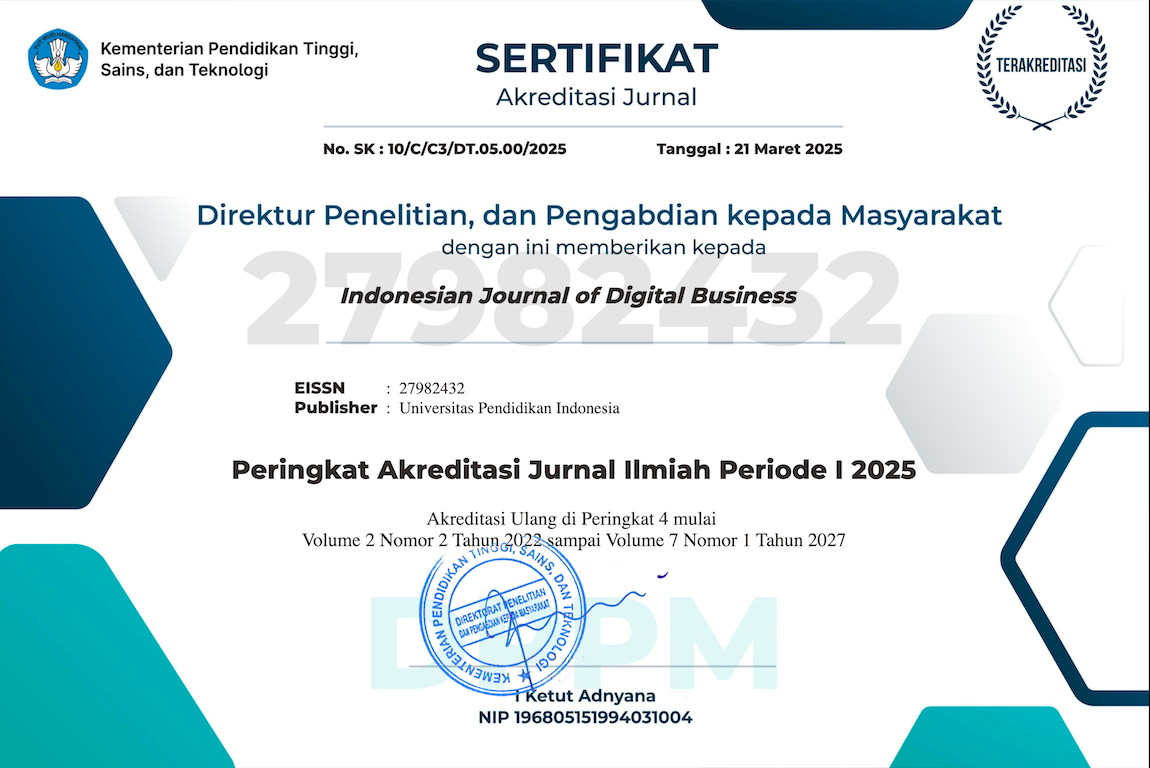Peramalan Nilai Ekspor Kepulauan Riau Menggunakan Model ARIMA dan Implikasinya pada Bisnis Digital
Abstract
Keywords
Full Text:
PDFReferences
Atasoy, B. S. (2020). The determinants of export sophistication: Does digitalization matter? International Journal of Finance & Economics. 2020, 1-25. https://doi.org/10.1002/ijfe.2058
Bai, C., Dallasega, P., Orzes, G., & Sarkis, J. (2023). Industry 4.0 technologies: Implementation patterns in manufacturing SMEs. International Journal of Production Economics, 256, 108764. https://doi.org/10.1016/j.ijpe.2022.108764
Box, G. E. P., Jenkins, G. M., Reinsel, G. C., & Ljung, G. M. (2020). Time series analysis: Forecasting and control (5th ed.). John Wiley & Sons.
Hyndman, R. J., & Athanasopoulos, G. (2021). Forecasting: Principles and practice (3rd ed.). OTexts. https://otexts.com/fpp3/
Li, F. (2020). The digital transformation of business models in the creative industries: A holistic framework and emerging trends. Technovation, 92-93, 333–338. https://doi.org/10.1016/j.technovation.2017.12.004
Li, P., Chen Y., Guo X. (2025). Digital Transformation and SupplyCchain Resilience. International Review of Economics and Finance, 99, 104033. https://doi.org/10.1016/j.iref.2025.104033
Makridakis, S., Spiliotis, E., & Assimakopoulos, V. (2018). Statistical and machine learning forecasting methods: Concerns and ways forward. PLOS ONE, 13(3), e0194889. https://doi.org/10.1371/journal.pone.0194889
Özsoy, S., Ergüzel, O. Ş., Ersoy, A. Y., & Saygılı, M. (2021). The impact of digitalization on export of high technology products: A panel data approach. The Journal of International Trade & Economic Development, 31(2), 277–298. https://doi.org/10.1080/09638199.2021.1965645
Schwab, K., & Zahidi, S. (2022). The global competitiveness report 2022. World Economic Forum. https://www.weforum.org/reports/global-competitiveness-report-2022/
Shumway, R. H., & Stoffer, D. S. (2017). Time Series Analysis and Its Applications (4th ed.). Springer.
Teng, X., Wu, Z., & Yang, F. (2022). Research on the Relationship between Digital Transformation and Performance of SMEs. Sustainability, 14(10), 6012. https://doi.org/10.3390/su14106012
DOI: https://doi.org/10.17509/ijdb.v5i1.85626
Refbacks
- There are currently no refbacks.
Copyright (c) 2025 Universitas Pendidikan Indonesia (UPI)

This work is licensed under a Creative Commons Attribution-ShareAlike 4.0 International License.
Indonesian Journal of Digital Business is published by Universitas Pendidikan Indonesia (UPI)
and managed by Department of Digital Business
Jl. Dr. Setiabudi No.229, Kota Bandung, Indonesia - 40154
View My Stats





1.png)